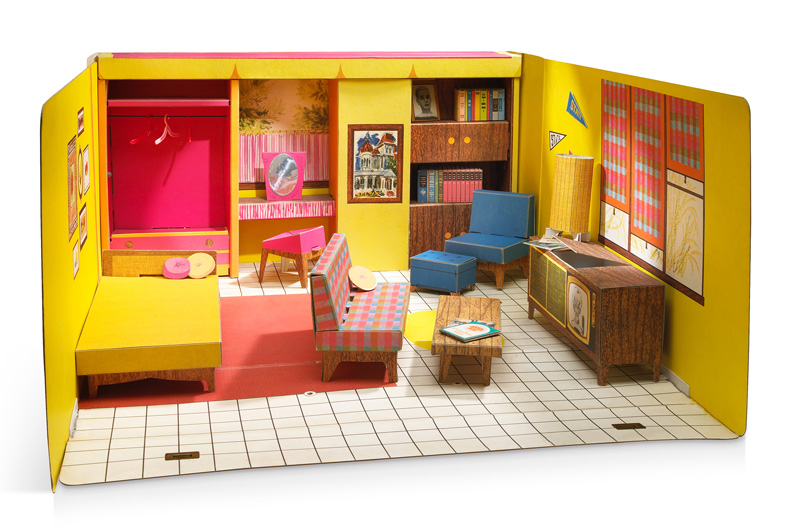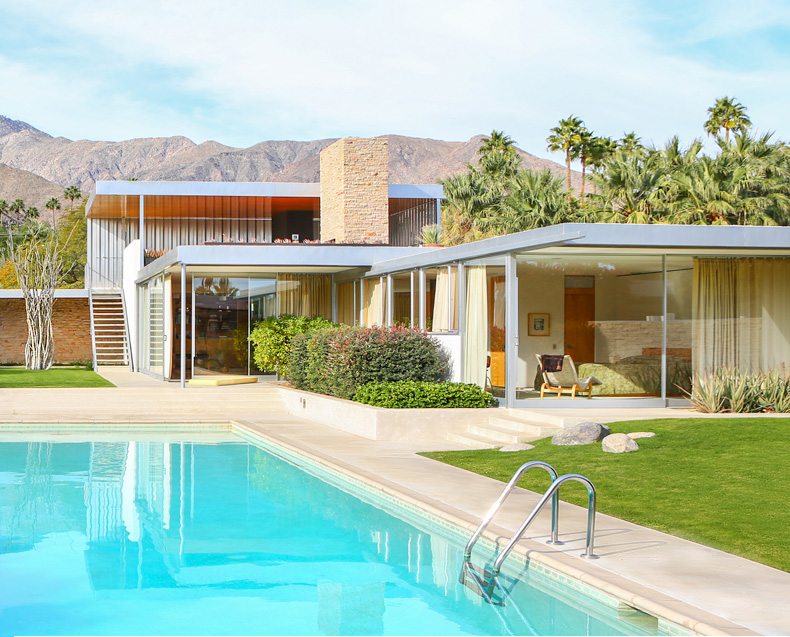When Barbie was given her first Dreamhouse, in 1962, a kitchen was conspicuously absent. Barbara Millicent Roberts was not, as most other dolls were at the time, there to teach young girls the art of being a good housewife and a good mother. Her modernist bachelorette pad – made of cardboard – had a sleek single bed, an integrated hi-fi-TV console, and other clean-lined furniture reminiscent of the work of contemporary designers such as George Nelson. Books lined the shelves and varsity pennants decorating one wall hinted at a college education. This iteration of Barbie, you feel sure, wouldn’t have uttered the words ‘Math class is tough’ (Teen Talk Barbie, 1992).
This was the kind of career-minded role model that Ruth Handler, co-founder of Mattel toy company and Barbie’s inventor, wanted for young girls. In Greta Gerwig’s new fuchsia-saturated film about Handler’s creation, the arrival of the first Barbie on to the market in 1959 is given a significance equivalent to the Dawn of Man, via a riff on the opening of Stanley Kubrick’s 2001: A Space Odyssey (1986). ‘Because Barbie can be anything, women can be anything,’ was the idea. And Barbie, certainly, could be anything: Astronaut Barbie came out in 1965, beating Neil Armstrong to the moon by four years; President Barbie arrived in 1992. In the film, Margot Robbie’s Stereotypical Barbie can in blissful ignorance subscribe to the creed spoken by the narrator (Helen Mirren) that ‘Thanks to Barbie, all problems of feminism and equal rights have been solved!’ (She has yet to discover that the Real World has never had a female POTUS.)
Barbie’s original Dreamhouse of 1962 pays homage to contemporary design. Photo: © Mattel

The Dreamhouse has gone through various forms and styles over the decades, reflecting both American real-estate trends and its owner’s increasing association with the colour pink (it’s always just Barbie’s place: independent woman that she is, she never shacks up with or marries Ken; and she never has children – even if, controversially at the time, her friend Midge does). There was the chalet-style A-frame Dreamhouse in 1979; the colonial, four-foot-wide pink Magical Mansion in 1990, its interiors grand, floral, and status-affirming; Barbie’s Funhouse was issued in 2021, a post-pandemic, Instagram-ready party pad full of retro furniture and gadgets for the gal who has everything.
When we find her in Gerwig’s film, her Dreamhouse has come more or less full-circle in terms of architectural style. Barbie’s pad here is undoubtedly more ‘fabulous’ than its 1962 ancestor, but Gerwig and her production team have gone back to the 1950s and ’60s – to Barbie’s origins – for their reference points. This is a sort of fantasia on Palm Springs, with everything looking like a souped-up, consciously tacky version of a Slim Aarons photograph. Production designer Sarah Greenwood and set decorator Katie Spencer have cited Richard Neutra’s Kaufmann House (1946) as one inspiration, and you can see the parallels: flat rooflines with overhangs, endless right angles, a central, block-like chimney. (They even looked to the 1950s for the backdrop, hand-painting the San Jacinto mountains to evoke the artificial-looking sets of musicals of the era – think Singin’ in the Rain, etc. I’m also reminded of Ed Ruscha’s eerie, sunset-tinged images of California.)
Model home: Kauffmann House in Palm Springs, designed in 1946 by Richard Neutra, inspired many of the key features of Barbie’s Dreamhouse. Photo: Fred Moser/flickr (used Creative Commons licence CC BY-NC-SA 2.0)

Taking that mid-century modern inside-outside continuum to the extreme, Barbie’s house – together with the three other near-identical Dreamhouses in the Barbieland cul-de-sac – has no exterior walls. Why would you need privacy when you having nothing to hide? Modernist touches continue within the open-plan rooms – Eero Saarinen’s Tulip chairs, modular sofas. On a fuchsia-pink dining table, confections inspired by Wayne Thiebaud’s pie paintings add another layer to the sense of cool-yet-crackers playhouse.
The only element of pink in the 1962 Dreamhouse was Barbie’s built-in wardrobe, the interior of which was painted a Pop-y tone which combined deliciously with the butter yellow of the rest of the room. Gerwig and co. have excelled themselves with Barbie’s walk-in, Chanel-heavy wardrobe upstairs, taking a cue from Clueless but also recreating on a life-size scale the immaculate box-fresh presentation of each new doll. Gerwig has talked about wanting to capture the feeling she had as a child, standing rapt in Toys ‘R’ Us in front of a display of Barbies, with their different outfits, believing them to be the most beautiful things she had ever seen. (I was in a different aisle, thinking the same kind of thoughts about a wooden toolbox.)
The ‘inciting incident’ of the film is that Barbie, in the midst of her perfect, Barbie world, starts thinking about death; she malfunctions. Cellulite appears on her thighs, and her feet, up to this point arched so that they naturally fit high heels, become flat, prompting melodramatic dry-heaving from the other Barbies and Kens, and the excellent line ‘I would never wear heels if my feet were shaped this way!’ Since her house is, of course, a perfect extension of her perfect self, things start to go wrong in her physical surroundings, too. Kitchen appliances fail, the milk goes off: the dream of the Dreamhouse is literally souring.
To find out what’s gone wrong – her owner may have been playing with her too hard – she needs to travel to the Real World; it’s a journey of many stages, the first of which is that she must choose a brown Birkenstock over a pink heel. When Barbie arrives in reality – L.A., natch – with a stowaway Ken (Ryan Gosling), the rollerblading pair have very different epiphanies. Barbie gets unwanted male attention and yelled at by a Gen Z-er, who tells her ‘You’ve been making women feel bad about themselves since you were invented,’ and calls her a fascist. Ken, meanwhile, drinks in cultural imagery and messaging such as white men on dollar bills, Rocky, Bill Clinton and dismissive hand gestures. He discovers the patriarchy.
On his return to Barbieland, Ken duly imports not only his new ideas about gender-defined roles, but also an accompanying design aesthetic. He and his other Ken pals have turned the Dreamhouses into man caves, or Mojo Dojo Casa Houses, with a surfeit of TVs, horse imagery and beer-stocked mini-fridges. The production designers may have missed a trick here, though. In 2009 a Parisian concept store marketed ‘Barbie Foot’, a very pink version of table football in which, you guessed it, the usually featureless players were replaced with Barbie dolls. But perhaps the idea of 22 armless women skewered on poles was too much, even for this film.
Thankfully, order – and decor – in Barbieland is restored, and Ken replaces his short-lived Sylvester Stallone look with a hoodie proclaiming ‘I am Kenough’. For Barbie, however, life here is not quite enough. ‘I want to be plastic,’ Andy Warhol famously proclaimed (he also did a Barbie silkscreen in 1986). Barbie, it turns out, is the anti-Warhol: she’s plastic, but wants to be human. So – ultimate spoiler alert – she returns to L.A. for good. We don’t see where she ends up living; but she’s sure as Ken’s abs going to get a shock when confronted with real estate in the Real World. Mortgage Defaulting Barbie, anyone?
Barbie is on general release in cinemas everywhere.


